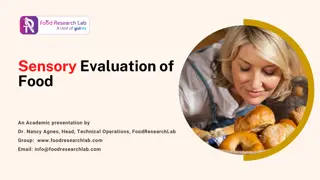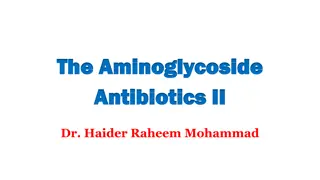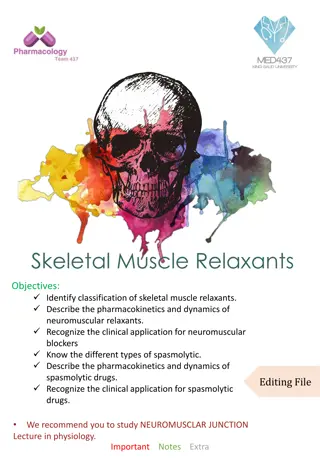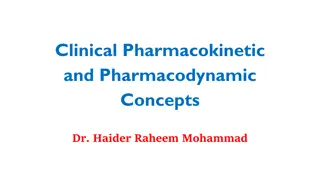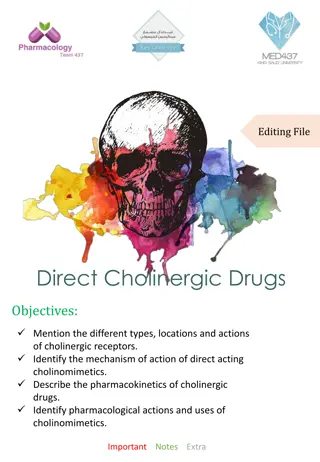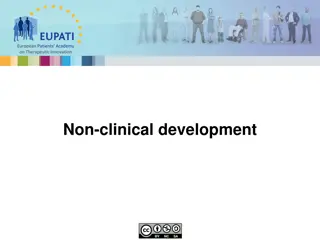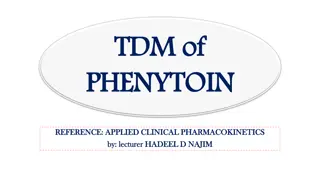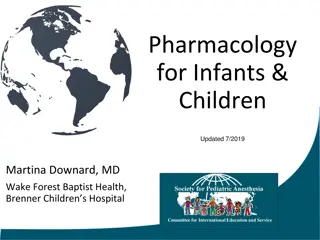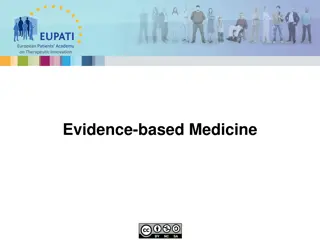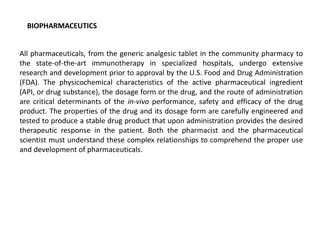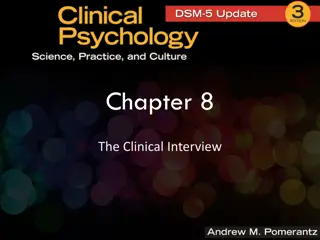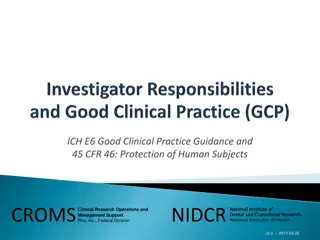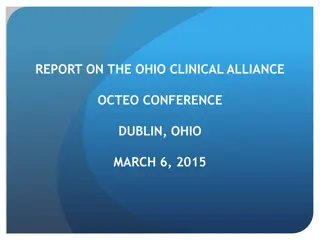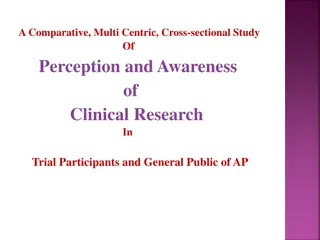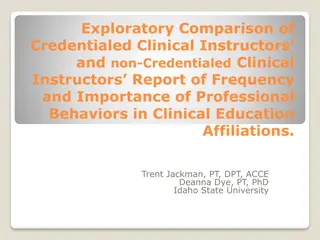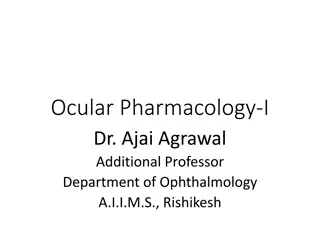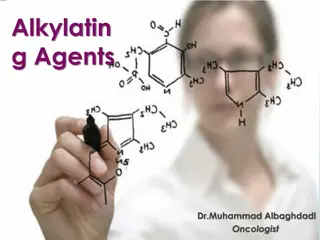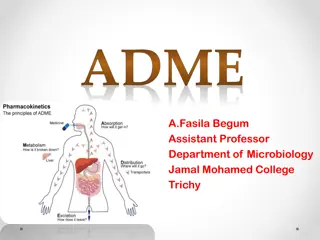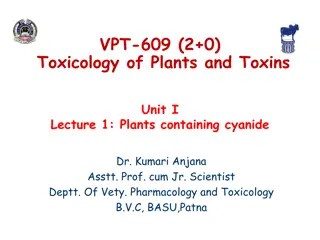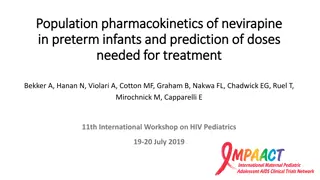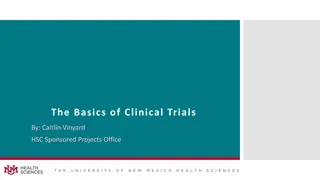Pharmacokinetics Lecture: Clinical Applications and Dosage Regimens
Explore the pharmacokinetics lecture focusing on clinical implications such as changes in drug half-life in various patient conditions. Learn about dosage regimen design and optimization, including considerations for achieving therapeutic drug levels. Discover clinical situations requiring dosage ad
4 views • 53 slides
_Sensory Evaluation of Food
Guires industry experts co-create the concept through your vision & formulate science-based food prototypes for start-ups, global brands & major retailers. Guires FRL bridges the boundaries of preclinical study with experts in pharmacokinetics and pharmacodynamics for market competitive product deve
2 views • 19 slides
Understanding Posology in Pharmacology: Factors Affecting Drug Dosage
Posology, the science of determining drug dosage, is influenced by various factors including age, sex, body weight, route of administration, and more. Changes in pharmacokinetics with age, differing drug responses in men and women, and the importance of body weight in dosing are crucial consideratio
6 views • 23 slides
Understanding Pharmacokinetics in Clinical Pharmacology
Pharmacokinetics, as explained in a lecture by Oula Mohammed Sami, M.B.Ch.B/MSc in clinical pharmacology, delves into how the body processes drugs, contrasting with pharmacodynamics which focuses on drug actions. Key topics covered include properties influencing treatment outcomes, the significance
5 views • 45 slides
Understanding Aminoglycoside Antibiotics and Dosing Strategies
Aminoglycoside antibiotics are potent but require precise dosing due to variability among patients. Suggested dosing adjustments based on serum concentrations can ensure therapeutic levels without toxicity. Various methods, like linear pharmacokinetics, individualized dosing, and computerized progra
16 views • 71 slides
Historical Development and Principles of Pharmacology
Explore the historical roots of pharmacology from ancient civilizations like India, China, and Egypt. Learn about the development and principles of drug activity, including pharmacokinetics and pharmacodynamics. Discover early medicinal practices and the evolution of drug administration. Gain insigh
1 views • 50 slides
India Alliance Clinical & Public Health fellowship in India
India Alliance Clinical & Public Health fellowship in India\n\nIndia Alliance Clinical and Public Health Research Fellowships are for Health researchers with an MD, MS, MPH, or an equivalent clinical or public health degree, who can apply for the DBT\/Wellcome Trust India Alliance Clinical and Publi
0 views • 5 slides
Understanding Aspirin Toxicity: Overview and Management
Aspirin toxicity, though decreasing in incidence, can still result in severe consequences such as metabolic acidosis, seizure, and even death. This condition is often underestimated due to lack of familiarity with its clinical presentation. Treatment focuses on maintaining salicylate in the ionized
0 views • 22 slides
Ethical Issues in Clinical Pharmacy Research by Dr. Haider Raheem Mohammad
Research ethics play a crucial role in clinical trials and therapeutic research in the field of pharmacy. From discovery to validation, all medicines undergo rigorous evaluation processes to ensure safety, efficacy, and freedom from adverse effects. Clinical trials in both animals and humans are ess
0 views • 20 slides
Advanced Clinical Practice Framework and Pillars of Practice
The document discusses the advanced clinical practice framework and the four pillars of practice which include leadership & management, clinical practice, education, and research. It emphasizes the importance of core capabilities and area-specific competence in advanced clinical practice. The role o
2 views • 8 slides
Objective Structured Clinical Examination (OSCE): A Modern Approach to Assessing Clinical Competence
The Objective Structured Clinical Examination (OSCE) is a modern examination method widely used in the field of health science to evaluate clinical skill performance. It involves stations where medical students interact with simulated patients to demonstrate competencies such as history taking, phys
1 views • 40 slides
Understanding Local Anesthetics: Mechanism, Characteristics, and Pharmacokinetics
Local anesthetics (LAs) block nerve impulse conduction effectively for pain management without motor blockade. Their chemistry, including lipophilic groups and ionizable groups, contributes to their efficacy. LAs have rapid onset, long duration, reversibility, and minimal side effects. Pharmacokinet
0 views • 30 slides
NIMH Clinical Research Education and Monitoring Program Overview
NIMH's Clinical Monitoring and Clinical Research Education, Support, and Training Program (CREST) aims to ensure the proper conduct, recording, and reporting of clinical trials. This program includes clinical monitoring plans, guidelines for site monitoring activities, and independent clinical monit
1 views • 29 slides
Skeletal Muscle Relaxants: Classification, Pharmacokinetics, and Clinical Applications
Skeletal muscle relaxants encompass different types, including neuromuscular blockers, spasmolytic drugs, and peripherally-acting agents. They are classified based on mechanisms of action and play crucial roles in inducing skeletal muscle relaxation for various clinical applications. Understanding t
2 views • 12 slides
Understanding Clinical Pharmacokinetic and Pharmacodynamic Concepts
Clinical pharmacokinetics involves applying pharmacokinetic principles to personalize medication dosages for optimal therapeutic effects while minimizing adverse reactions. It covers drug absorption, distribution, metabolism, and excretion. Pharmacodynamics focuses on the relationship between drug c
0 views • 55 slides
Understanding Cholinergic Drugs: Receptors, Actions, and Pharmacology
Learn about the types, locations, and actions of cholinergic receptors, the mechanism of action of direct-acting cholinomimetics, pharmacokinetics of cholinergic drugs, and the pharmacological actions and uses of cholinomimetics. Explore the roles of nicotinic and muscarinic receptors in the nervous
4 views • 12 slides
Understanding Non-Clinical Development in Therapeutic Innovation
The European Patients Academy on Therapeutic Innovation focuses on the non-clinical development phase of medicine, delving into efficacy assessment, safety evaluation, and manufacturing process considerations. Non-clinical studies are essential for decision-making in clinical trials, marketing appli
1 views • 26 slides
Overview of Anxiety Disorders and Antianxiety Drugs
Anxiety disorders are conditions characterized by excessive worry and fear that can interfere with daily life. Common types include generalized anxiety disorder, panic disorder, phobias, and OCD. Treatment options include psychotherapy and anxiolytic drugs such as benzodiazepines, 5HT1A agonists, be
0 views • 25 slides
Digoxin Pharmacokinetics and Clinical Considerations
This presentation covers the pharmacokinetic parameters, dosing guidelines, therapeutic and toxic concentrations, and factors affecting digoxin clearance and distribution. It explores how digoxin clearance is linked to creatinine clearance, usual dosing regimens for adult patients, and disease state
0 views • 41 slides
Understanding Phenytoin Therapy - Clinical Pharmacokinetics and Serum Concentrations
Phenytoin, a medication with high protein binding and hepatic metabolism, exhibits saturated pharmacokinetics with a narrow therapeutic range of 10-20 µg/mL for total serum concentrations. Adverse effects vary with serum levels: minor CNS depression at >15 µg/mL, nystagmus at >20 µg/mL, and ataxi
0 views • 55 slides
Pediatric Pharmacology Update: Perioperative Medications in Infants and Children
Gain insights on frequently used medications in the perioperative period for infants and children, including anesthesia medications. Explore pharmacokinetics, drug distribution in neonates, and the effects of common anesthesia agents on pediatric patients. Understand how immature kidney or liver fun
0 views • 43 slides
Understanding Evidence-Based Medicine and Clinical Decision-Making
European Patients Academy on Therapeutic Innovation emphasizes the importance of Evidence-Based Medicine (EBM) in providing optimum clinical care. EBM involves systematic review and utilization of clinical research for informed decision-making, benefiting patients in disease management and treatment
7 views • 20 slides
Understanding Digoxin Pharmacology and Clinical Use
Digoxin, a cardiac glycoside, is utilized in managing congestive heart failure and atrial fibrillation due to its inotropic and chronotropic effects on the heart. It functions by inhibiting Na,K-ATPase, leading to increased intracellular calcium concentrations and augmented myocardial contractility.
5 views • 23 slides
Understanding Biopharmaceutics and Pharmacokinetics in Drug Development
Biopharmaceutics and pharmacokinetics play essential roles in the research, development, and optimization of pharmaceutical products. Biopharmaceutics focuses on the interrelationship of drug properties, dosage forms, and administration routes on drug absorption, while pharmacokinetics delves into d
0 views • 16 slides
Understanding Fluconazole: Mechanism, Spectrum, and Clinical Applications
Explore the mechanism of action, spectrum of activity, pharmacokinetics, and clinical uses of fluconazole. Learn about its role in treating various fungal infections, including candidiasis, cryptococcosis, and dermatophytosis, while being aware of resistance issues and dosing considerations.
0 views • 30 slides
Essential Aspects of the Clinical Interview in Psychology
Clinical interviews play a crucial role in the assessment conducted by clinical psychologists, showcasing essential qualities like validity, reliability, and clinical utility. Understanding the importance of feedback and honing general and specific skills as an interviewer are key components in cond
1 views • 17 slides
Comprehensive Overview of Propofol: Mechanism, History, and Pharmacokinetics
Propofol is a widely used IV hypnotic with a unique mechanism of action involving GABA receptors and dopamine modulation. Its history, from initial anaphylactic reactions to current emulsion formulations, is intriguing. Understanding its pharmacokinetics, including metabolism in the liver and kidney
0 views • 59 slides
Laboratory Related CRFs for Pharmacokinetics Study
This collection encompasses various CRFs related to laboratory procedures in the context of Pharmacokinetics for a study. It includes forms for enrollment, specimen storage, safety laboratory results, and specific days for sample collection. The CRFs detail the storage, collection, and documentation
0 views • 14 slides
Clinical Research Guidelines and Regulations Overview
Clinical research encompasses various guidelines and regulations to ensure the protection of human subjects and the credibility of study results. Key aspects include Good Clinical Practice (GCP) standards, Title 45 of the Code of Federal Regulations (CFR) Part 46, and additional CFR sections for cli
0 views • 46 slides
Ohio Clinical Alliance: Transforming Clinical Experiences
The Ohio Clinical Alliance, through collaborative partnerships, aims to enhance clinical preparation for educators. The leadership team comprises various representatives and organizations committed to improving student learning. Their activities include retreats and meetings to ensure effective comm
0 views • 27 slides
Perception and Awareness of Clinical Research in Trial Participants and the Public of Andhra Pradesh
This study focuses on understanding the perception and awareness of clinical research among trial participants and the general public in Andhra Pradesh. It highlights the importance of creating awareness about clinical research, previous study results, public attitudes towards clinical trials, and e
0 views • 24 slides
Comparison of Professional Behaviors in Clinical Education
Professional behavior characteristics play a crucial role in enhancing student learning during clinical education. This study examines the differences in reported importance and frequency of professional behaviors between credentialed and non-credentialed clinical instructors. The background outline
0 views • 28 slides
Understanding Ocular Pharmacology - An Overview by Dr. Ajai Agrawal
Explore the intricate world of ocular pharmacology with Dr. Ajai Agrawal, an Additional Professor at A.I.I.M.S., Rishikesh. The learning objectives cover pharmacokinetics, pharmacodynamics, and various routes of drug administration in ocular treatments. Delve into the anatomy of the eye, tear film c
0 views • 51 slides
Enhancing Clinical Academic Collaboration Between Universities and NHS Trusts
Clinical academics play a crucial role in integrating clinical practice, research, and education within the NHS. Collaboration between universities and NHS trusts is key to ensure clinical academics address the right questions for patient care and societal benefit. Challenges include an aging clinic
0 views • 29 slides
Understanding Alkylating Agents in Oncology: Mechanisms and Pharmacokinetics
Alkylating agents have a long history as anti-cancer drugs, with Mechlorethamine being the first developed in 1942. They react with cells in all phases of the cell cycle, causing DNA alkylation and cross-link formation. Common alkylating agents include Cyclophosphamide, Melphalan, and Temozolomide.
0 views • 75 slides
Understanding ADME in Pharmacokinetics and Pharmacology
Pharmacokinetics and pharmacology, focused on ADME processes, play a crucial role in drug development and delivery. Absorption, distribution, metabolism, and excretion determine how drugs interact within the body. Absorption involves transfer into the bloodstream, while distribution entails the spre
0 views • 12 slides
Understanding Cyanogenic Plants and Cyanide Poisoning in Animals
This lecture introduces the toxicology of plants containing cyanide, focusing on factors affecting cyanide poisoning, cyanogenic plants, mechanisms of toxicosis, clinical signs, post-mortem lesions, diagnosis, treatment, and prevention. It discusses species variations in susceptibility, plant growth
0 views • 22 slides
Overview of Skeletal Muscle Relaxants and Neuromuscular Blockers
Skeletal muscle relaxants and neuromuscular blockers are important drugs used to induce muscle relaxation. They are classified based on their site of action and mechanism of action. Understanding their classification, pharmacokinetics, and clinical applications is crucial for medical professionals.
0 views • 25 slides
Population Pharmacokinetics of Nevirapine in Preterm Infants
Population pharmacokinetics of nevirapine in preterm infants were evaluated to predict the doses needed for treatment. Early antiretroviral treatment recommendations for neonates, challenges with available ARV formulations, and the importance of data to inform nevirapine dosing in preterm infants we
1 views • 17 slides
Understanding Clinical Trials: Phases, Types, and Definitions
Clinical trials play a crucial role in advancing medical research and treatment options. This comprehensive guide covers the basics of clinical trials, including their definition, phases, types, and key definitions like IND, IDE, NDA, and more. Discover how different phases of trials work, the vario
0 views • 16 slides

